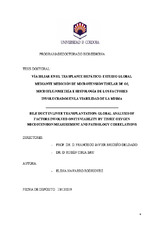Vía biliar en el trasplante hepático: estudio global mediante medición de microtensión tisular de O2, microflujometría e histología de los factores involucrados en la viabilidad de la misma
Bile duct in liver transplantation: global analysis of factors involved on its viability by tissue oxygen microtension measurement and pathology correlations
Autor
Navarro Rodríguez, Elena
Director/es
Briceño Delgado, Francisco JavierCiria, Rubén
Editor
Universidad de Córdoba, UCOPressFecha
2020Materia
Trasplantes hepáticosVías biliares
Anastomosis biliar
Microoxigenación biliar
Microangiopatía biliar
Complicaciones biliares
METS:
Mostrar el registro METSPREMIS:
Mostrar el registro PREMISMetadatos
Mostrar el registro completo del ítemResumen
Background and aims: Biliary anastomosis is a frequent area of complications after liver transplantation (LT) and a potential area of “microangiopathy”. The concept of a “marginal bile duct” is unexplored. The main aim was to make a preliminary evaluation of the utility of an innovative real-time oxygen microtension (pO2mt) testing device for the assessment of bile duct viability during LT and to correlate these pO2mt values with microvascular tissue quality by histopathology and outcomes. Patients and methods: Observational prospective cohort study with 23 patients. Oxygen microtension measurements were made placing a micropO2 probe in different areas of recipient and donor’s bile duct intraoperative. A correlation with pathological findings including several parameters of biliary quality was performed. Results: Mean pO2mt in the graft bile duct at the level of the anastomosis 103.82 (31-157) mm Hg, being 121.52 (55-174) mm Hg 1.5 cm proximal to the hilar plate (P < 0.001). Mean pO2mt in the recipient’s bile duct was 117.87 (62-185) mm Hg, while a value of 137.30 (81-198) mm Hg was observed 1.5 cm distal to the anastomosis (P < 0.001). Cystic duct resection (12 cases) was also related with higher pO2mt values at anastomosis [117.8 (93-157) vs 88.54 (31-124) mm Hg] and distal to anastomosis [135.6 (111-174) vs 106.2 (55-133) mm Hg; P < 0.001]. In the pathological correlations, impairment in mural strom (P=0.001) and disruption in peribiliary vascular plexus (P=0.007) in the donor side correlated with lower rates of pO2 measurements. In the recipient side, disruption of the epithelium (P=0.007), most severe inflammation (P=0.042) and disruption in peribiliary vascular plexus (P=0.025) correlated also with reduced pO2 measurements. Patients with 1-, 3-, and 12-month biliary complications had significantly lower pO2mt in the intraoperative measurements in both donor and recipients’ sides. Conclusion: Our preliminary results show that distal borders of donor and recipient bile ducts may be low-vascularized areas. Tissue pO2mt is significantly higher in areas close to the hilar plate and to the duodenum in donor and recipient’s sides, respectively. Bile duct injury and biliary complications are associated with worse tissue pO2mt.

